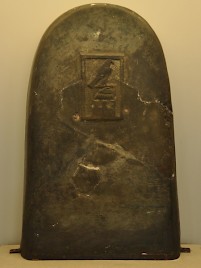Den
Den: king of Egypt's First Dynasty, probably ruling for 42-47 years in the first half of the twenty-ninth century BCE.
Innovations

In the tomb of King Den, as well as in the tombs of various officials in Saqqara, various objects – such as wooden and ivory labels containing texts and images - have enabled historians to piece together some of this king's life. The general view is that he introduced several important innovations in the early Egyptian state. He promoted developments within administration and organization, art, architecture, and religion during his reign, which must be placed in the decades before and/or after c. 2900 BCE.
One innovation was to employ Egyptian numerals to calculate taxes and record significant year events. Another innovation concerns Den’s titles: he is the first pharaoh in Egyptian history to receive the Nsw-bity or "Throne Name”, Semti. Of the pharaoh’s five titles, this was the one he adopted at his accession and it refers to his rule of Upper and Lower Egypt.note
Den is also the first king represented wearing the double-crown, or pschent. This was a combination of the red deshret crown of Naqada and the white hedjet crown of Hierakonpolis, and represented the unification of Egypt. The image of Den wearing the pschent crown was discovered on an ivory label in his tomb at Abydos. Finally, one of the two famous regalia which symbolized the pharaoh’s authority in ancient Egypt is seen for the first time and connected to Den: the flail, or nekhakha, which represented the fertility of the land. Its counter half was the crook or heka, which stood for kingship.
King Den’s tomb
King Den’s tomb contains various innovative elements as well. First of all, it is the largest and most finely built tomb in the Umm-el-Qaab necropolis of Abydos, consisting not only of the conventional mudbricks, but stone elements as well, such as a granite floor. A second innovative feature is the stairwell leading to the entry of the tomb. Finally, the tomb is surrounded by burial sites for no less than 136 persons. These men and women were presumably servants, who may have been strangled to death in order to serve the pharaoh in the afterlife.
Human sacrifice was not an unusual practice in the Early Dynastic Period and such burial sites have been attested near other first dynasty tombs. During the Second Dynasty, this custom seems to have gone out of fashion, presumably due to its costliness and waste of talent. As early as the Old Kingdom, the problem of the king who needed servants was solved by including ushabti’s amongst the grave goods: small mummy-formed statuettes inscribed with incantations, which the deceased could magically control and would serve him.